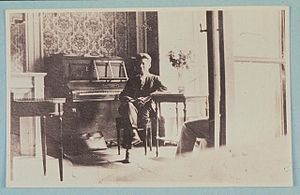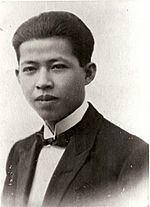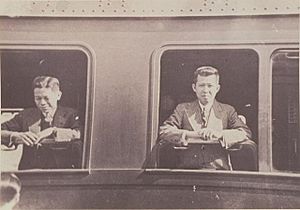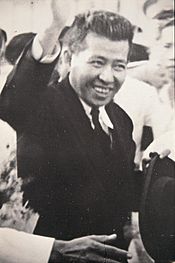Pridi Banomyong facts for kids
Quick facts for kids
Pridi Banomyong
NR PChW MPCh MWM GCMG KmstkVO
|
|
|---|---|
|
ปรีดี พนมยงค์
|
|

Pridi in 1945
|
|
| 7th Prime Minister of Thailand | |
| In office 24 March 1946 – 23 August 1946 |
|
| Monarch | |
| Preceded by | Khuang Aphaiwong |
| Succeeded by | Thawan Thamrongnawasawat |
| Regent of Thailand | |
| In office 16 December 1941 – 5 December 1945 |
|
| Monarch | Ananda Mahidol |
| Prime Minister |
|
| Minister of Finance | |
| In office 24 March 1946 – 23 August 1946 |
|
| Prime Minister | himself |
| Preceded by | Phya Srivisaravaja |
| Succeeded by | Vijitr Luritanon |
| In office 20 December 1938 – 16 December 1941 |
|
| Prime Minister | Plaek Phibunsongkhram |
| Preceded by | Serm Kritsanamara |
| Succeeded by | Pao Pienlert Boripanyutakit |
| Minister of Foreign Affairs | |
| In office 12 July 1936 – 13 December 1938 |
|
| Prime Minister | Phraya Phahonphonphayuhasena |
| Preceded by | Phya Srisena |
| Succeeded by | Chao Phya Sridharmadhibes |
| Minister of Interior | |
| In office 29 March 1934 – 12 February 1935 |
|
| Prime Minister | Phraya Phahonphonphayuhasena |
| Preceded by | Phraya Phahonphonphayuhasena |
| Succeeded by | Thawan Thamrongnawasawat |
| Personal details | |
| Born | 11 May 1900 Ayutthaya, Siam |
| Died | 2 May 1983 (aged 82) Paris, France |
| Nationality | Thai |
| Political party | Khana Ratsadon |
| Other political affiliations |
Free Thai Movement |
| Height | 1.60 m (5 ft 3 in) |
| Spouse | Poonsuk Banomyong |
| Children | 6 |
| Alma mater |
|
| Signature | |
Pridi Banomyong (Thai: ปรีดี พนมยงค์, RTGS: Pridi Phanomyong, pronounced [prīː.dīː pʰā.nōm.jōŋ]; 11 May 1900 – 2 May 1983) was an important Thai politician and professor. He was also known by his noble title Luang Praditmanutham (Thai: หลวงประดิษฐ์มนูธรรม). Pridi served as a Regent (someone who rules for a king who is too young or absent), a prime minister, and held many government minister jobs in Thailand. He was a key leader of the group called Khana Ratsadon, which means "People's Party." He also founded University of Moral and Political Sciences and the Bank of Thailand.
Pridi was born into a farming family in Ayutthaya Province. Despite this, he received a good education. He became one of Thailand's youngest lawyers in 1919, at just 19 years old. In 1920, he won a scholarship to study in France. He earned a master's degree from the University of Caen and a doctorate from the University of Paris in 1927. That same year, he helped start the Khana Ratsadon group with other Thai students living abroad.
After returning to Thailand (then called Siam), he worked as a judge and professor. He played a big part in writing two of the country's first constitutions after the 1932 Siamese Revolution. He also suggested an economic plan, but it was not well-received, and he had to leave the country for a short time. When he came back, he held many important government jobs. He helped modernize Thai laws, set up local governments, and worked to cancel old, unfair treaties with Western countries. He also helped reform the tax system.
Pridi disagreed with Plaek Phibunsongkhram when Phibunsongkhram seemed to want to become a dictator in the 1930s. This started a long rivalry between the two leaders. Pridi became a regent from 1941 to 1945, a role that had little power at the time. During World War II, he secretly led the Free Thai Movement inside Thailand. This group worked against the Japanese. After the war, he was seen as a respected elder statesman. He was briefly Prime Minister in 1946. However, his political opponents blamed him for the mysterious death of King Ananda Mahidol. A military takeover in 1947 caused him to lose his political power. An attempt to regain power in 1949 failed, and Pridi spent the rest of his life living outside Thailand. He passed away in Paris in 1983, and his ashes were brought back to Thailand three years later.
Pridi's image has been seen in different ways, from a supporter of democracy to someone who wanted a republic. The claims that he was a communist or involved in the King's death are now seen as politically motivated. His opponents continued to use these claims even after he died. However, Pridi won every lawsuit in Thailand against people who spread these ideas. He became a symbol of fighting against military dictatorships and a symbol of freedom and Thammasat University. In 2000, UNESCO celebrated the 100th anniversary of his birth.
Contents
Family Background
Pridi wrote that his ancestor, Heng, came from China to Siam around 1758–1767. Heng fought against Burmese invaders and died serving the king. His family later received compensation.
Heng's grandson, Tan Nai Kok, moved to Siam in 1814. He settled in Ayutthaya and sold Chinese and Thai sweets. He was a devout Buddhist and married a Thai woman named Pin. Pin's sister, Boonma, was an ancestor of Pridi's wife, Poonsuk.
Nai Kok's son, Nai Koet, married Khum, a rich Chinese businesswoman. When Nai Koet died, his wife had his remains cremated. They were placed at a shrine on Phanomyong Hill. This is where the family's Thai surname, Banomyong, comes from. Nai Koet's son, Nai Siang, became a wealthy rice merchant. He and his wife, Lukchan, were Pridi's parents.
Early Life and Education
Pridi Phanomyong was born in Tha Wasukri, Ayutthaya Province. He was the second of five children. In 1915, his family dropped "Nai" from their names because of a royal order. He finished high school at Suankularb Wittayalai School.
After getting his law degree and becoming a lawyer in 1919, he received a government scholarship. This allowed him to study law and economics in Paris. While studying there, he started gathering a group of about 50 government workers. They wanted to change the absolute monarchy to a constitutional monarchy, where the king's power is limited by a constitution. He earned a law PhD and a higher diploma in economics.
In 1927, he returned to Siam to work for the Ministry of Justice. He quickly moved up in rank. He was given the royal title Luang Praditmanutham (Thai: หลวงประดิษฐ์มนูธรรม).
Political Career
The People's Party and New Ideas
On 24 June 1932, a small group called Khana Ratsadon, or the People's Party, carried out a quick takeover. Pridi was a leader of the civilian part of this group. This event suddenly ended 150 years of absolute monarchy in Thailand. The country then moved towards a constitutional monarchy.
In 1933, Pridi wrote a plan for the country's economy. It was called the "Yellow cover dossier." This plan suggested big changes like the government owning land and providing jobs for everyone. Some royalists and former members of Khana Ratsadon did not like this plan. They even closed down parliament and the courts. Pridi was accused of being a communist and had to leave the country for a short time. However, many of his ideas, like a national bank, later became reality.
Government Roles and Achievements
Pridi came back to Thailand in 1934. He founded Thammasat University as an open university, meaning it was open to many students. That same year, he became the Minister of the Interior. He then served as Minister of Foreign Affairs from 1935 and Minister of Finance from 1938.
As Minister of Foreign Affairs from 1936 to 1937, Pridi signed agreements that removed the special rights of 12 countries in Thailand. These rights, called extraterritorial rights, meant foreigners were not fully under Thai law or taxes. By ending these, Thailand became more independent in its legal and tax systems. This was the first time since unfair treaties were forced upon Thailand during the reign of King Rama IV.
Pridi and Field Marshal Plaek Phibunsongkhram were friends at first. But they later disagreed, especially as Phibun became more militaristic. Pridi was against Japan and had more left-leaning ideas. He did not like Phibun's policies that seemed too friendly towards Japan. Their disagreements shaped Thailand's path during World War II.
Leading the Free Thai Movement
On 8 December 1941, Imperial Japan attacked parts of Southeast Asia, starting the Pacific War. This included attacks on Thailand. After some fighting, the Thai government allowed the Japanese to pass through the country. They also let Japan use Thai military bases to attack other Allied areas.
When Field Marshal Plaek Phibunsongkhram declared war on Britain and the United States in January 1942, Pridi refused to sign it. He was serving as the Regent for the young King, who was studying in Switzerland. In this role, Pridi secretly built an anti-Japanese network in Thailand called the Free Thai Movement ("Seri Thai"). He contacted the Allies and Thai resistance groups in Britain and the United States.
As the war continued and Japan started losing, people in Thailand became unhappy. Phibun was forced to resign as prime minister in 1944. Khuang Abhaiwongse, a lawyer and member of Seri Thai, became prime minister. He was chosen because he could pretend to cooperate with the Japanese. This helped protect the growing Seri Thai movement.
When Japan surrendered, ending the war, the Seri Thai-led government quickly acted. As regent, Pridi declared Phibun's declaration of war "illegal and null." He also canceled all agreements Phibun had made with Japan.
When Lord Louis Mountbatten, the Supreme Commander for Southeast Asia, visited Bangkok in late 1945, he praised Pridi. He said it was unique that he, an Allied commander, was sharing military plans with the leader of a country that was technically at war with them.
After the War
Pridi stopped being regent when King Ananda Mahidol returned in December 1945. He was officially named a Senior Statesman. He advised the governments of Thawi Bunyaket and Seni Pramoj.
In March 1946, Khuang Aphaiwong, who had been elected prime minister, resigned. Pridi became prime minister to try and calm the political situation. During his time as prime minister, the war crimes trial of Phibun was dismissed due to a legal issue. Pridi decided to run for political power himself. After his allies voted Khuang out, Pridi became the 8th Prime Minister in 1946.
During the Cold War, Thailand became important to the United States. Pridi supported the independence movement in Vietnam and wanted to create an anti-imperialist group in Southeast Asia. Because of this, he lost support from the U.S., which led to quiet support for a military takeover against him.
On 9 June 1946, King Ananda Mahidol was found dead from a gunshot wound. In October 1946, a committee said the King's death could not have been an accident. Pridi's political opponents quickly blamed him. Some even said he planned the assassination.
After a general election, Pridi resigned as prime minister. He went on a world tour, meeting leaders like Chiang Kai-shek and US president Harry S. Truman.
Pridi's opponents included royalists, conservatives, and military groups. On 8 November 1947, army troops took over government buildings in Bangkok. This takeover, led by Lieutenant General Phin Choonhavan, removed the government of Thamrong, who was Pridi's political ally. Pridi hid for a week. On 20 November, British and US agents helped him escape to Singapore. The 1947 takeover brought Phibun back to power and ended the People's Party's role in Thai politics.
Phibun arrested King Ananda's secretary and two of his pages. They were accused of planning to kill the king. Rumors spread that Pridi was involved in the King's death and wanted to make Thailand a republic. After a very unfair trial, three royal pages connected to Pridi were sentenced to death.
However, King Bhumibol Adulyadej did not believe that Pridi was involved in his brother's death.
Life in Exile
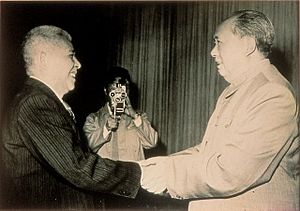
Pridi secretly returned to Thailand in 1949 to try and overthrow Phibun's government. When this failed, Pridi left for China. He never returned to Thailand. In 1970, he moved to France, where he lived the rest of his life. Pridi passed away on 2 May 1983, at his home near Paris.
Legacy and Recognition
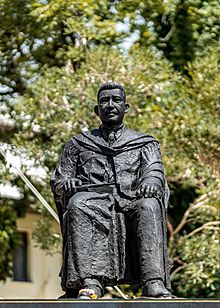
Pridi is still a debated figure in Thai history. As a leader of the 1932 pro-democracy movement, he is seen in many ways. The first statement of the "revolution," which strongly criticized the king, was written by Pridi. Yet, Pridi served as regent when King Rama VIII became king.
During military rule, Pridi was called a communist. This was because some of his writings showed support for ideas like Marxism and socialism.
Because of clear disagreements between Pridi and King Rama VIII, the young king's death was blamed on Pridi. He was accused of being the leader of a plot to kill the popular young king. This led to the military takeover in 1947.
Later in his life, Seni Pramoj claimed he saved Thailand from British colonial rule, which he said Pridi was willing to accept. However, many believe Pridi's actions during the war helped Thailand keep its independence. Pridi wanted to remove Phibun from power, and the war gave him a chance to do so. Even the Japanese knew Pridi was against them.
One-time conservative Sulak Sivaraksa has become a strong supporter of Pridi. Sulak has praised the Free Thai movement for saving Thailand's independence. He has also criticized Seni and his Democrat Party for supposedly helping the military return to power in 1947.
Sulak led efforts to improve Pridi's reputation, and they had good results. Four streets in Bangkok are now named after Pridi. His birthday, 11 May, is celebrated as Pridi Banomyong Day. In 1997, the Thai government dedicated a park in eastern Bangkok to the Free Thai resistance movement. On 16 August 2003, a library-museum, a copy of Pridi's wartime home, opened at the park.
On 30 October 1999, UNESCO recognized the 100th anniversary of Pridi Phanomyong's birth. This was a tribute to his ideas and honesty.
There are two Pridi Banomyong Memorials. One is in Pridi's hometown, and the other is at Thammasat University, which he founded. Thammasat is home to the Pridi Banomyong Library and the Pridi Banomyong International College. The law faculty at Dhurakij Pundit University is called the Pridi Banomyong Faculty of Law. A type of leafbird, the Pridi (Chloropsis aurifrons pridii), is named after him. The Pridi Banomyong Institute, a non-profit group, also holds an annual lecture in his honor.
Honors and Awards
Academic Recognition
- Professor of Thammasat University
Civil Service Rank
- Chief of Ministry of Justice of Siam (Thai: อํามาตย์ตรี)
Noble Title
- Luang Praditmanutham of Ministry of Justice of Siam (Thai: หลวงประดิษฐ์มนูธรรม) (1928-1941)
Royal Decorations from Thailand
Pridi received many honors in Thailand:
- 1933 -
 Safeguarding the Constitution Medal
Safeguarding the Constitution Medal - 1937 -
 Knight Grand Cordon (Special Class) of The Most Noble Order of the Crown of Thailand
Knight Grand Cordon (Special Class) of The Most Noble Order of the Crown of Thailand - 1938 -
 King Rama VIII Royal Cypher Medal
King Rama VIII Royal Cypher Medal - 1939 -
 Dushdi Mala Medal for Services to the Nation
Dushdi Mala Medal for Services to the Nation - 1941 -
 Knight Grand Cordon (Special Class) of the Most Exalted Order of the White Elephant
Knight Grand Cordon (Special Class) of the Most Exalted Order of the White Elephant - 1945 -
 Knight Grand Cross (First Class) of The Most Illustrious Order of Chula Chom Klao
Knight Grand Cross (First Class) of The Most Illustrious Order of Chula Chom Klao - 1945 -
 Knight of The Ancient and Auspicious Order of the Nine Gems
Knight of The Ancient and Auspicious Order of the Nine Gems
Foreign Decorations
He also received honors from other countries:
 Order of the Rising Sun, 1st Class (Japan)
Order of the Rising Sun, 1st Class (Japan) Grand Cross of the Légion d'honneur (France)
Grand Cross of the Légion d'honneur (France) Grand Cordon of the Order of Leopold (Belgium)
Grand Cordon of the Order of Leopold (Belgium) Grand Cross of the Order of Saints Maurice and Lazarus (Italy)
Grand Cross of the Order of Saints Maurice and Lazarus (Italy) Grand Cross of the Order of St Michael and St George (United Kingdom)
Grand Cross of the Order of St Michael and St George (United Kingdom) Medal of Freedom with Gold Palm (United States of America)
Medal of Freedom with Gold Palm (United States of America) Commander Grand Cross of the Order of Vasa (Sweden)
Commander Grand Cross of the Order of Vasa (Sweden) Grand Cross of the Order of the German Eagle (Germany), 1938
Grand Cross of the Order of the German Eagle (Germany), 1938 Grand Cross of the Order of the Dannebrog(Denmark)
Grand Cross of the Order of the Dannebrog(Denmark)
Images for kids
See also
 In Spanish: Pridi Banomyong para niños
In Spanish: Pridi Banomyong para niños


